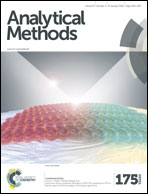Qualitative analysis of designer drugs by paper spray ionisation mass spectrometry (PSI-MS)†
Abstract
The application of ambient ionization mass spectrometry such as paper spray ionisation (PSI) is a fast, powerful, and simple method to analyze designer drugs directly on the surface of blotters. PSI-MS does not require nebulizing gas and heating temperature as well as complex protocols for sample preparation. Herein, it was possible to identify and elucidate the chemical structure of designer drugs using tandem mass spectrometry experiments from a triangular blotter. Substances such as lysergic acid diethylamide (LSD), and five new designer drugs (2,5-dimethoxy-4-chloroamphetamine (DOC), 2,5-dimethoxy-4-bromoamphetamine (DOB), 25C-NBOMe, 25B-NBOMe, and 25I-NBOMe) were characterized by PSI-MS. The PSI(+)-MS and PSI(+)-MS/MS data confirmed the assignments of the designer drugs and fragmentation mechanisms have been proposed. From losses of 17 Da (NH3), which is typical of primary amines, the CID results suggest the presence of isomers in the chemical composition of the NBOMe class. Additionally, the data were compared to those of ultra-high-resolution mass spectroscopy (positive-ion electrospray ionization coupled with Fourier transform ion cyclotron mass spectrometry, ESI(+)FT-ICR MS).

- This article is part of the themed collection: Analytical Chemistry in South America

 Please wait while we load your content...
Please wait while we load your content...